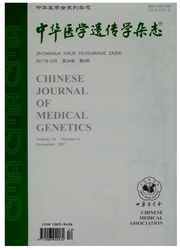

 中文摘要:
中文摘要:
目的确定一个中国人裂手足家系的致病性基因突变,探讨基因型一表型关系。方法收集患者及其家庭成员的外周血,提取基因组DNA。采用PCR扩增P63基因和HOXD13基因的外显子,对PCR产物进行双向测序检测基因突变。结果在所有患者中检测到P63基因第7外显子的杂合型956G→A突变,导致蛋白产物第280位的精氨酸被组氨酸取代(R280H)。在正常家庭成员中未检测到该突变。结论该家族中的患者以对称性裂手足伴并指趾为主要特征,由P63基因的R280H突变所致。
 英文摘要:
英文摘要:
Objective To determine the causative gene mutation in a Chinese family with split-hand/ split foot malformation (SHFM) and explore the genotype-phenotype relationship. Methods Genomic DNA was extracted from peripheral blood samples of the patients and their family members. Polymerase chain reaction (PCR) was performed to amplify all the exons of P63 gene and HOXD13 gene. Then the PCR products were sequenced bidirectionally to screen mutations. Results A heterozygous 956G→ A transversion in exon 7 of P63 gene was identified in all patients, which resulted in the substitution of histidine residue for arginine at position 280 of P63 protein (R280H). This mutation was not found in the unaffected family members. Conclusion Patients in this pedigree are characterized by symmetrical split hand and split foot with syndactyly. This condition is caused by the R280H mutation in P63 gene.
 同期刊论文项目
同期刊论文项目
 同项目期刊论文
同项目期刊论文
 期刊信息
期刊信息
